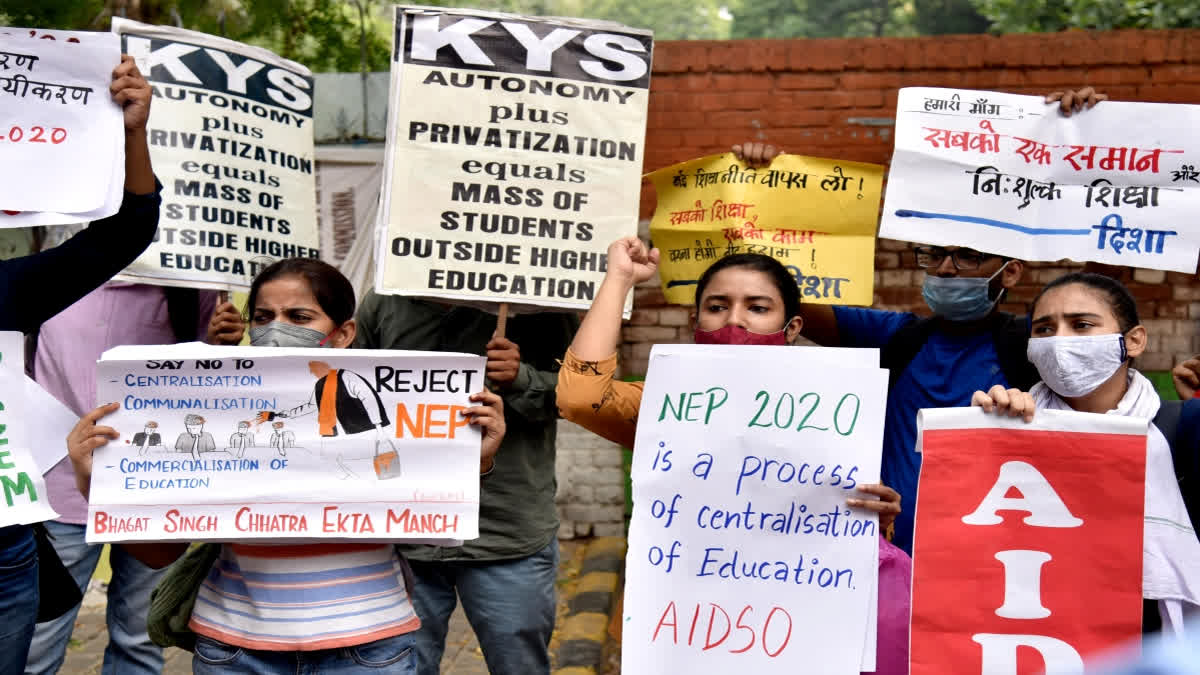Multiple Entry and Multiple Exit (MEME) as a feature was introduced in the National Education Policy (NEP) -2020, with the aim to make education accommodative, inclusive, diverse, learner-centric, flexible and aligned with the global best practices.
"The NEP 2020 seeks to reform the Higher Education system by providing, among other things, flexibility to students in terms of choice of subjects to study and academic pathways. A creative combination of disciplines for study with multiple entry and exit points is one of the major recommendations of NEP, 2020," the then MoS Education Subhas Sarkar, said in reply to a question in Lok Sabha during the winter session last year.
The reply came in to a question from Eluru (Andhra Pradesh) MP Sridhar Kotagiri, who wanted to know whether the Government is considering to develop new options for Multiple Entry and Multiple Exit (MEME) in NEP to resolve hurdles in managing MEME in several areas.
Sarkar also referred to the comprehensive guidelines issued by the University Grants Commission with regard to the MEME sheme for a better understanding.
File - Ministry of Education and Ministry of Skill Development and Entrepreneurship tableau, based on the theme 'Vedas to Metaverse' showcasing the key aspects of National Education Policy (NEP 2020), passes through the Rajpath during the 73rd Republic Day Parade, in New Delhi on 26 January, 2022 (ANI) What it aims to achieve?
The guidelines from the UGC, in its statement of objectives, listed out seven key aspects as its reasons which MEME would serve for.
The statement said it would remove rigid boundaries and facilitate new possibilities for learners while banking on reducing the dropout rate and improving GER (Gross Enrolment Ratio).
The MEME would offer creative combinations of disciplines of study. It would also offer flexibility in curriculum and novel course options to students, in addition to discipline-specific specialisations and different designs of the Master's programme.
The scheme would provide for credit accumulation and transfer along with provision of evaluation and validation of non-formal and informal learning for the award of a degree and encourage lifelong learning, while facilitating encashment of credits earned when the learner resumes his/her programmes of study.
Whilst the Union government is pushing hard for the several features of the NEP implementation in the States, the implementation of the MEME option in higher educational institutions (HEIs) is a chimera. It faces several impediments, let’s discuss them.
File - Union Home Minister Amit Shah during the launch of a new initiative under NEP on the completion of two years of National Education Policy 2020, at Ambedkar International centre in New Delhi on 29 July, 2022. (ANI) 'Curriculum Restructuring'
Institutions need to redesign their curricula to offer flexible and modular courses. It requires a massive overhaul in the academic programs and requires breaking down conventional degree programs into smaller, stackable certificates and diplomas, Permitting students to exit and re-enter at various stages. It can be a complex task for institutions with fixed structures and monolithic curriculums.
'Credit Transfer System'
MEME relies on a robust academic bank of credits (ABC), where students can accumulate and transfer credits across institutions. Developing and managing a comprehensive and transparent credit transfer system, which is accepted universally, presents logistical and administrative hurdles.
Besides, different Universities adopt different credit systems for subjects offered for their academic programs. Credit weightage for a subject may not necessarily be the same across all the HEIs nationally.
'Faculty Training and administrative challenges'
HEIs which are already constrained with shortage of teaching faculty need to adapt to new teaching methods and assessment patterns, which may differ significantly from traditional models. Moreover, managing students entering and exiting at different times could increase faculty workload, making it more difficult to ensure individualised attention.
The frequent movement of students in and out of courses demands more from administrative systems, such as student records management, fee structures, and tracking student progress. Institutions may need to invest in technology and personnel to manage these complexities.
File - Prime Minister Narendra Modi launches NEP 2020 initiatives during the inaugural conclave of Shikshak Parv through video conferencing, in New Delhi on 07 September, 2021. (ANI) ‘HEIs lack wherewithal’
The financial conditions of HEIs, especially State funded Universities, is no secret, which are struggling to pay pension benefits and salaries to its staff.
Providing flexible course offerings requires infrastructure (both hard and soft) viz.additional faculty, classrooms, labs, workshops and administrative support. Resource-constrained HEIs may find it challenging to provide the infrastructure necessary for MEME. Lackadaisical attitude of the government towards HEIs further exacerbate this situation.
‘Recognition by Employers and placement challenges’
While MEME allows students to gain certificates or diplomas after exiting a program, it is uncertain whether these credentials will be widely accepted by employers, especially in professional fields where full degrees are traditionally required.
The way forward
These challenges suggest that while the MEME system has the potential to improve flexibility and access in higher education, its implementation requires a significant overhaul of existing systems, mindsets, and resources. Above all, it needs a uniform syllabi and credit scheme policy across all HEIs, which further compromises with their autonomy and may invite resistance from Universities.
Instead of adopting the sledgehammer approach, it is imperative that MEME, in the initial stage, be implemented in certain limited post graduate programs, where enrolment is relatively low, as a pilot project and lessons learnt thereafter may decide future course of action while taking care of interests of all stakeholders.
(Disclaimer: The opinions expressed in this article are those of the writer. The facts and opinions expressed here do not reflect the views of ETV Bharat)
